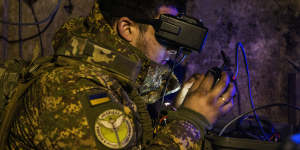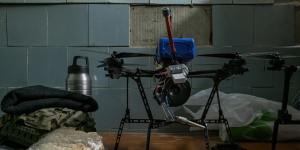Over the past two months,Russian forces have taken out five of the 31 American-made M1 Abrams tanks that the Pentagon sent to Ukraine late last year,a senior US official said. At least another three have been moderately damaged since the tanks were sent to front lines early this year,said Colonel Markus Reisner,an Austrian military trainer who closely follows how weapons are being used – and lost – in the war in Ukraine.

A destroyed Russian tank near the village of Sulyhivka,in the Kharkiv region of Ukraine.The New York Times
That is a sliver of the 796 of Ukraine’s main battle tanks that have been destroyed,captured or abandoned since the war began in February 2022,according to Oryx,a military analysis site that counts losses based on visual evidence. A vast majority of those are Soviet-era,Russian or Ukrainian-made tanks;only about 140 of those taken out in battle were given to Ukraine by NATO states.
Russia has so far lost more than 2900 tanks,the Oryx data show,although Ukraine claims that the number exceeds 7000.
German Leopard tanks have also been targeted in Ukraine:at least 30 have been destroyed,Oryx says. But the American Abrams is widely viewed as one of the world’s mightiest. That it is being more easily taken out by exploding drones than some officials and experts had initially assumed shows “yet another way the conflict in Ukraine is reshaping the very nature of modern warfare”,said Can Kasapoglu,a defence analyst at the Hudson Institute in Washington.
A Highly Accurate Killer
Despite their power,tanks are not impenetrable,and they are most vulnerable where their heavy plated armor is the thinnest:on the top,the rear engine block and the space between the hull and the turret. For years they were mainly targeted with land mines,improvised explosive devices,rocket-propelled grenades and anti-tank guided missiles,like “shoot and scoot” shoulder-fired systems. These were widely used early in the Ukraine war because they could strike tanks from above and hit them up to 90 per cent of the time.

A Ukrainian soldier remotely pilots an FPV drone from an underground bunker.The New York Times
The drones that are now being used against tanks in Ukraine are even more accurate. Known as first-person view drones,or FPVs,they are equipped with a camera that streams real-time images back to their controller,who can direct them to hit tanks in their most vulnerable spots. In several cases,the FPVs have been sent in to “finish off” tanks that had already been damaged by mines or anti-tank missiles so that they could not be retrieved from the battlefield and repaired,Reisner said.
Depending on their size and technological sophistication,the drones can cost as little as $US500 ($770) – a paltry investment for taking out a $US10 million ($15.5 million) Abrams tank. Some of them can carry munitions to boost the impact of their blast,said Reisner. These could be rocket-propelled grenades,he said,or self-forging warheads known as explosively formed penetrators,or EFPs,that were widely used in roadside bombs during the Iraq War. Reisner has collected videos of tanks in Ukraine being chased down by the drones or drones flying into their open turrets.
“Welcome to the 21st century – it’s unbelievable,actually,” said Reisner,a historian and former armor reconnaissance officer who oversees Austrian forces’ training at the Theresian Military Academy.
No Easy Way to Defend
In November,within weeks of receiving the Abrams tanks,Ukrainian President Volodymyr Zelensky said:“It is difficult for me to say that they play the most important role on the battlefield. Their number is very small.”
Some officials and experts believe Ukraine’s commanders had planned to save the Abrams for future offensive operations next year and resisted sending them to the front lines,where they risked losing the few they had. Instead,the tanks deployed early this year with the American-trained and equipped 47th Mechanised Brigade as Ukraine sought but failed to maintain control of Avdiivka,a stronghold in the eastern Donbas area that fell to Russian troops in February.
Reisner said drones,potentially including FPVs,may have been able to pick off the Abrams tanks because the 47th Brigade did not appear to have the protection of short-range air defence systems like the self-propelled,German-designed Gepard cannons that help safeguard Kyiv.
FPVs can be stopped with jammers that disrupt their connection to the remote pilot. Shotguns and even simple fishing nets have been used to destroy or catch some of them on Ukraine’s battlefields.

A kamikaze drone being prepared for action by Ukrainian soldiers.The New York Times
“At this stage,the most effective means used to defeat FPVs is electronic warfare and various types of passive protection,” including additional armor and other kinds of shielding on the tanks,said Michael Kofman,a senior fellow in the Russia and Eurasia program at the Carnegie Endowment for International Peace in Washington. He said defeating FPVs required a “tailored approach on the battlefield” and that Ukrainian forces were becoming more adept at it.
But Reisner suggested that Ukraine was so desperate for air defences that it was depriving tanks of full protections by sending Gepards or other short-range anti-aircraft weapons that would traditionally deploy to the front lines to instead protect cities and critical infrastructure.
So Are Tanks Obsolete?
Reisner said military engineers had sought new ways to destroy tanks for as long as they have been used on the battlefield and that the FPVs did not render the Abrams and other advanced tanks like the German Leopards obsolete in Ukraine.
“If you want to seize terrain,you need a tank,” Reisner said of the single most lethal weapon in ground warfare.
But he added that the FPVs were a key part of what some analysts believed would drive future warfare underground,with remote-controlled weapons fighting it out on the surface. In this circumstance,soldiers would direct weapon systems from nearby underground bunkers to ensure they could maintain lines of sight and radio frequency over the weapons.
Such land battles could largely pit first-person view drones against unmanned ground vehicles,Reisner said:“They will be fighting each other like inThe Terminator.”
This article originally appeared in.
Get a note directly from our foreign correspondents on what’s making headlines around the world..